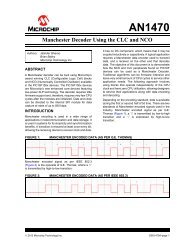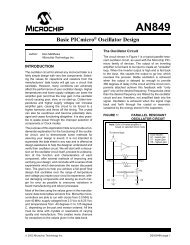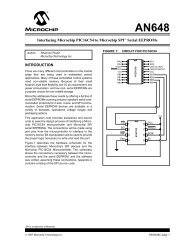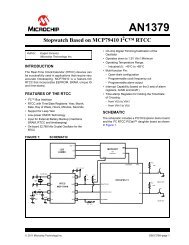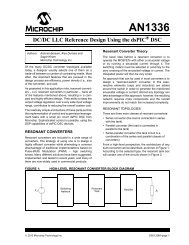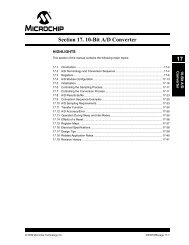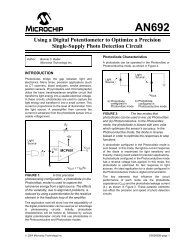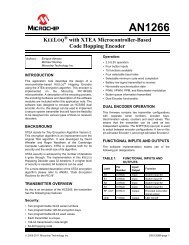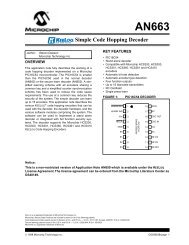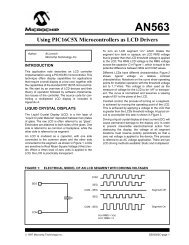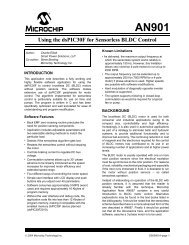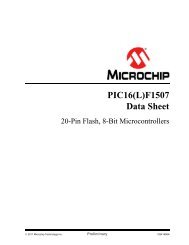AN1193, Using C to Interface 8051 MCUs with SPI Serial ... - Microchip
AN1193, Using C to Interface 8051 MCUs with SPI Serial ... - Microchip
AN1193, Using C to Interface 8051 MCUs with SPI Serial ... - Microchip
Create successful ePaper yourself
Turn your PDF publications into a flip-book with our unique Google optimized e-Paper software.
<strong>AN1193</strong><br />
<strong>Using</strong> C <strong>to</strong> <strong>Interface</strong> <strong>8051</strong> <strong>MCUs</strong> <strong>with</strong> <strong>SPI</strong> <strong>Serial</strong> EEPROMs<br />
Author:<br />
INTRODUCTION<br />
Alexandru Valeanu<br />
<strong>Microchip</strong> Technology Inc.<br />
The 25XXX series serial EEPROMs from <strong>Microchip</strong><br />
Technology support a half-duplex pro<strong>to</strong>col that<br />
functions on a master-slave paradigm that is ideally<br />
suited <strong>to</strong> data stream applications. The bus is<br />
controlled by the microcontroller (master), which<br />
accesses the 25XXX serial EEPROM (slave) via a<br />
simple <strong>Serial</strong> Peripheral <strong>Interface</strong> (<strong>SPI</strong>) compatible<br />
serial bus. Bus signals required are a clock input (SCK)<br />
plus separate data in (SI) and data out (SO) lines.<br />
Access <strong>to</strong> the 25XXX serial EEPROM is controlled<br />
through a Chip Select (CS) input. Maximum clock<br />
frequencies range from 3 MHz <strong>to</strong> 20 MHz.<br />
Communication <strong>to</strong> the 25XXX serial EEPROM can be<br />
paused via the hold pin (HOLD) if the clock line is<br />
shared <strong>with</strong> other peripherals on the <strong>SPI</strong> bus. While the<br />
EEPROM is paused, transitions on its inputs are<br />
ignored, <strong>with</strong> the exception of CS, allowing the MCU <strong>to</strong><br />
service higher priority interrupts. After releasing the<br />
HOLD pin, operations resume from the point when the<br />
hold was asserted.<br />
The main features of the 25XXX serial EEPROMs are:<br />
• <strong>SPI</strong>-compatible serial interface bus<br />
• EEPROM densities from 128 bits <strong>to</strong> 512 Kbits<br />
• Bus speed from 3 MHz <strong>to</strong> 20 MHz<br />
• Voltage range from 1.8V <strong>to</strong> 5.5V<br />
• Low power operation<br />
• Temperature range from -40°C <strong>to</strong> +125°C<br />
• Over 1,000,000 erase/write cycles<br />
• Built-in write protection<br />
This application note is part of a series that provide<br />
source code <strong>to</strong> help the user implement the pro<strong>to</strong>col<br />
<strong>with</strong> minimal effort.<br />
Figure 1 is the hardware schematic depicting the interface<br />
between the <strong>Microchip</strong> 25XXX series serial<br />
EEPROMs and NXP’s P89LPC952 <strong>8051</strong>-based MCU.<br />
The schematic shows the connections necessary<br />
between the MCU and the serial EEPROM as tested.<br />
The software was written assuming these connections.<br />
The WP and HOLD pins are tied <strong>to</strong> VCC<br />
through resis<strong>to</strong>rs, because the write-protect and hold<br />
features are not used in the examples provided.<br />
FIGURE 1:<br />
CIRCUIT FOR P89LPC952 MCU AND 25XXX SERIAL EEPROM<br />
Vcc (1)<br />
P89LPC952<br />
34<br />
33<br />
32<br />
31<br />
P2.1/MOSI<br />
P2.3/MISO<br />
P2.4/SS<br />
P2.5/<strong>SPI</strong>CLK<br />
CS<br />
SO<br />
1<br />
2<br />
25XX256<br />
8<br />
7<br />
Vcc<br />
HOLD (2)<br />
WP (2)<br />
3<br />
6<br />
SCK<br />
Vss<br />
4<br />
5<br />
SI<br />
Note 1: A decoupling capaci<strong>to</strong>r (typically 0.1 µF) should be used <strong>to</strong> filter noise on VCC.<br />
Note 2: WP and HOLD pins should have pull-up resis<strong>to</strong>rs (2 kΩ <strong>to</strong> 10 kΩ).<br />
© 2008 <strong>Microchip</strong> Technology Inc. DS01193A-page 1
<strong>AN1193</strong><br />
FIRMWARE DESCRIPTION<br />
This application note offers designers a set of<br />
examples for the read and write functions for the<br />
<strong>Microchip</strong> <strong>SPI</strong> serial EEPROM (byte read/write and<br />
page read/write) using a main routine and the bit-bang<br />
method, which implements serial communication on<br />
any MCU, including those lacking built-in serial<br />
support. The main routine writes a string in the <strong>SPI</strong><br />
serial EEPROM, reads it back and compares the two<br />
strings, displaying the results on LEDs on an evaluation<br />
board. Moreover, the main routine sends the results of<br />
the read <strong>to</strong> the UART <strong>to</strong> verify the correctness of<br />
operations.<br />
The firmware is written in the <strong>8051</strong>’s C compiler for the<br />
NXP P89LPC952 MCU using the Keil µVision ® IDE.<br />
It was developed on the Keil MCB950 evaluation<br />
board. The code can easily be modified <strong>to</strong> use any<br />
available I/O lines.<br />
The code was tested using the 25XX256 serial<br />
EEPROM. The EEPROM features 32K x 8 (256 Kbit)<br />
of memory and 64-byte pages. Oscilloscope screen<br />
shots are shown in this application note. All timings are<br />
based on the internal RC oscilla<strong>to</strong>r of the MCU<br />
(7.373 MHz). If a faster clock is used, the code must be<br />
modified <strong>to</strong> generate the correct delays.<br />
The bus speed in these examples is ~ 300 kHz. As<br />
explained in the applicable <strong>SPI</strong> serial EEPROM data<br />
sheets, the maximum allowed bus speed depends on<br />
the EEPROM’s operating voltage. If desired, the bus<br />
speed may be decreased by introducing supplementary<br />
delays in the low-level routines (spi_wr and<br />
spi_rd).<br />
DS01193A-page 2<br />
© 2008 <strong>Microchip</strong> Technology Inc.
<strong>AN1193</strong><br />
INITIALIZATION<br />
Initialization consists of two routines: ini_spi and<br />
ini_memspi. The ini_spi routine prepares the<br />
MCU for communication <strong>with</strong> the serial EEPROM using<br />
the bit-bang method, and the ini_memspi routine<br />
prepares the serial EEPROM for further writes.<br />
The structure of the initialization operation is as follows:<br />
Write Enable (WREN) + Write STATUS Register (WRSR)<br />
+ WRITE (#NOPROT = 00). The scope plot showing<br />
this operation appears in Figure 2.<br />
FIGURE 2:<br />
WRITE TO STATUS REGISTER<br />
CS<br />
SCK<br />
0 1 2 3 4 5 6 7<br />
Command<br />
0 1 2 3 4 5 6 7 8<br />
Command<br />
9 10 11 12 13 14 15<br />
Data <strong>to</strong> STATUS Register<br />
SI<br />
0 0 0 0 0 1 1 0<br />
0 0 0 0 0 0 0 1 7 6 5 4 3 2 1 0<br />
SO<br />
High-Impedance<br />
© 2008 <strong>Microchip</strong> Technology Inc. DS01193A-page 3
<strong>AN1193</strong><br />
WRITE ENABLE<br />
Before a write operation <strong>to</strong> the serial EEPROM can<br />
occur, the MCU must set the Write Enable Latch<br />
(WEL). This is done by issuing a WREN command.<br />
The MCU clears the WEL bit by issuing a Write Disable<br />
command (WRDI). The WEL bit is also au<strong>to</strong>matically<br />
reset if the serial EEPROM is powered down or if a<br />
write cycle is completed.<br />
Figure 3 shows the WREN and WRITE pair of<br />
commands.<br />
FIGURE 3:<br />
WRITE ENABLE AND WRITE COMMANDS<br />
CS<br />
SCK<br />
0 1 2 3 4 5 6 7<br />
Command<br />
0 1 2 3 4 5 6 7 8<br />
Command<br />
9 10 11<br />
Data <strong>to</strong> S<br />
SI<br />
0 0 0 0 0 1 1 0<br />
0 0 0 0 0 0 1 0 7 6 5 4<br />
SO<br />
High-Impedance<br />
DS01193A-page 4<br />
© 2008 <strong>Microchip</strong> Technology Inc.
<strong>AN1193</strong><br />
BYTE WRITE<br />
The byte write operation consists of the following<br />
components: the WRITE command followed by the<br />
word address and data byte. The word address for the<br />
25XX256 is a 16-bit value, so two bytes must be transmitted<br />
for the entire word address, <strong>with</strong> the Most<br />
Significant Byte sent first. Note that the WREN<br />
instruction is not illustrated in this section but is still<br />
required <strong>to</strong> initiate the operation.<br />
Figure 4 shows the sequence WRITE (02), the MSB<br />
address (00) and LSB address (40h) and the first<br />
written byte (43h).<br />
FIGURE 4:<br />
WRITE COMMAND AND WORD ADDRESS<br />
CS<br />
SCK<br />
SI<br />
SO<br />
0 1 2 3 4 5 6 7 8<br />
9 10 11 21 22 23 24 25 26 27 28 29 30 31<br />
Command 16-Bit Address Data Byte<br />
0 0 0 0 0 0 1 0 15 14 13 12 2 1 0 7 6 5 4 3 2 1 0<br />
High-Impedance<br />
Twc<br />
© 2008 <strong>Microchip</strong> Technology Inc. DS01193A-page 5
<strong>AN1193</strong><br />
BYTE READ<br />
The byte read operation can be used <strong>to</strong> read data from<br />
the serial EEPROM. The MCU transmits the command<br />
byte followed by the word address bytes <strong>to</strong> the serial<br />
EEPROM.<br />
Figure 5 shows an example of the READ command,<br />
followed by the MSB and LSB address bytes, followed<br />
by the first read byte.<br />
FIGURE 5:<br />
BYTE READ (COMMAND BYTE, WORD ADDRESS AND FIRST READ BYTE)<br />
CS<br />
SCK<br />
SI<br />
0 1 2 3 4 5 6 7 8 9 10 11 21 22 23 24 25 26 27 28 29 30 31<br />
Command<br />
16-Bit Address<br />
0 0 0 0 0 0 1 1 15 14 13 12 2 1 0<br />
SO<br />
High-Impedance<br />
Data Out<br />
7 6 5 4 3 2 1 0<br />
DS01193A-page 6<br />
© 2008 <strong>Microchip</strong> Technology Inc.
<strong>AN1193</strong><br />
PAGE WRITE<br />
Page write operations provide a technique for<br />
increasing throughput when writing large blocks of<br />
data. The 25XX256 serial EEPROM features a 64-byte<br />
page. By using the page write feature, up <strong>to</strong> 1 full page<br />
of data can be written consecutively.<br />
It is important <strong>to</strong> point out that page write operations are<br />
limited <strong>to</strong> writing bytes <strong>with</strong>in a single physical page,<br />
regardless of the number of bytes actually being<br />
written. Physical page boundaries start at addresses<br />
that are integer multiples of the page size, and end at<br />
addresses that are [integer multiples of the page size]<br />
minus 1. Attempts <strong>to</strong> write across a page boundary<br />
result in the data being wrapped back <strong>to</strong> the beginning<br />
of the current page, thus overwriting any data<br />
previously s<strong>to</strong>red there.<br />
The page write operation is very similar <strong>to</strong> the byte write<br />
operation. The serial EEPROM au<strong>to</strong>matically increments<br />
the internal Address Pointer <strong>to</strong> the next higher<br />
address <strong>with</strong> receipt of each byte.<br />
Figure 6 shows two consecutive data bytes during a<br />
page write operation.<br />
FIGURE 6:<br />
PAGE WRITE (FIRST TWO CONSECUTIVE DATA BYTES)<br />
CS<br />
SCK<br />
SI<br />
0 1 2 3 4 5 6 7 8<br />
9 10 11 21 22 23 24 25 26 27 28 29 30 31<br />
Command 16-Bit Address Data Byte 1<br />
0 0 0 0 0 0 1 0 A 15 A 14 A 13 A 12 A 2 A 1 A 0 7 6 5 4 3 2 1 0<br />
CS<br />
SCK<br />
SI<br />
32 33 34 35 36 37 38 39 40<br />
Data Byte 2<br />
7 6 5 4 3 2 1 0<br />
41 42 43 44 45 46 47<br />
Data Byte 3<br />
7 6 5 4 3 2 1 0<br />
Data Byte n (64 max)<br />
7 6 5 4 3 2 1 0<br />
© 2008 <strong>Microchip</strong> Technology Inc. DS01193A-page 7
<strong>AN1193</strong><br />
PAGE READ<br />
Page read operations read a complete string, starting<br />
<strong>with</strong> the specified address. In contrast <strong>to</strong> page write<br />
operations described on the previous page, there is no<br />
maximum length for page read. After 64 Kbytes have<br />
been read, the internal address counter rolls over <strong>to</strong> the<br />
beginning of the array.<br />
Figure 7 depicts the entire sequence of commands<br />
necessary <strong>to</strong> perform the page read operation. For<br />
clarity, only the first three read bytes are shown.<br />
FIGURE 7:<br />
PAGE READ (FIRST THREE READ BYTES)<br />
CS<br />
SCK<br />
0 1 2 3 4 5 6 7 8 9 10 11 21 22 23 24 25 26 27 28 29 30 31<br />
Command<br />
16-bit Address<br />
SI<br />
0<br />
0<br />
0<br />
0<br />
0 1 A 15 A 14 A 13 A 12 A 2 A 1 A 0<br />
7 6 5 4 3 2 1 0<br />
0 1<br />
SO<br />
High-Impedance<br />
Data Byte 1<br />
DS01193A-page 8<br />
© 2008 <strong>Microchip</strong> Technology Inc.
<strong>AN1193</strong><br />
BYTE WRITE VERSUS PAGE WRITE<br />
At first glance, the page write method appears superior<br />
<strong>to</strong> the byte write method: it’s simpler and faster.<br />
However, a careful analysis shows that the byte write<br />
method has a major advantage over page write owing<br />
<strong>to</strong> the roll-over phenomenon (see Note).<br />
Note:<br />
Page write operations are limited <strong>to</strong> writing<br />
bytes <strong>with</strong>in a single physical page,<br />
regardless of the number of bytes actually<br />
being written. Physical page boundaries<br />
start at addresses that are integer<br />
multiples of the page buffer size (or page<br />
size), and they end at addresses that are<br />
integer multiples of [page size-1]. If a<br />
Page Write command attempts <strong>to</strong> write<br />
across a physical page boundary, the<br />
result is that the data wraps around <strong>to</strong> the<br />
beginning of the current page (overwriting<br />
data previously s<strong>to</strong>red there) instead of<br />
being written <strong>to</strong> the next page as might be<br />
expected. It is therefore necessary for the<br />
application software <strong>to</strong> prevent page write<br />
operations that would attempt <strong>to</strong> cross a<br />
page boundary.<br />
As a consequence of the roll-over phenomenon, applications<br />
that write long strings <strong>to</strong> the <strong>SPI</strong> serial<br />
EEPROM risk overlapping the page boundary in the<br />
middle of a string. In such instances, the firmware<br />
should use byte write <strong>to</strong> avoid this condition. The disadvantage<br />
of doing this is the slower speed involved in<br />
writing the entire string: every byte write cycle time is<br />
approximately 5 ms.<br />
The following summarizes the differences between the<br />
byte write and page write methods.<br />
Byte Write<br />
• Is slower – It needs a 5 ms write cycle time for<br />
each byte.<br />
• Is more general – It may write a string of any<br />
length.<br />
Page Write<br />
• Is faster – It needs only one write cycle time for<br />
the whole page.<br />
• Care must be taken <strong>to</strong> observe page boundaries<br />
during page writes.<br />
CONCLUSION<br />
This application note offers designers a set of firmware<br />
routines <strong>to</strong> access <strong>SPI</strong> serial EEPROMs. The code<br />
demonstrates byte and page operations. All routines<br />
were written in C for an <strong>8051</strong>-based MCU.<br />
The code was developed on the Keil MCB950<br />
evaluation board using the schematic shown in<br />
Figure 1. It was tested using the NXP P89LPC952<br />
MCU and debugged using the Keil µVision3 IDE.<br />
© 2008 <strong>Microchip</strong> Technology Inc. DS01193A-page 9
<strong>AN1193</strong><br />
NOTES:<br />
DS01193A-page 10<br />
© 2008 <strong>Microchip</strong> Technology Inc.
Note the following details of the code protection feature on <strong>Microchip</strong> devices:<br />
• <strong>Microchip</strong> products meet the specification contained in their particular <strong>Microchip</strong> Data Sheet.<br />
• <strong>Microchip</strong> believes that its family of products is one of the most secure families of its kind on the market <strong>to</strong>day, when used in the<br />
intended manner and under normal conditions.<br />
• There are dishonest and possibly illegal methods used <strong>to</strong> breach the code protection feature. All of these methods, <strong>to</strong> our<br />
knowledge, require using the <strong>Microchip</strong> products in a manner outside the operating specifications contained in <strong>Microchip</strong>’s Data<br />
Sheets. Most likely, the person doing so is engaged in theft of intellectual property.<br />
• <strong>Microchip</strong> is willing <strong>to</strong> work <strong>with</strong> the cus<strong>to</strong>mer who is concerned about the integrity of their code.<br />
• Neither <strong>Microchip</strong> nor any other semiconduc<strong>to</strong>r manufacturer can guarantee the security of their code. Code protection does not<br />
mean that we are guaranteeing the product as “unbreakable.”<br />
Code protection is constantly evolving. We at <strong>Microchip</strong> are committed <strong>to</strong> continuously improving the code protection features of our<br />
products. Attempts <strong>to</strong> break <strong>Microchip</strong>’s code protection feature may be a violation of the Digital Millennium Copyright Act. If such acts<br />
allow unauthorized access <strong>to</strong> your software or other copyrighted work, you may have a right <strong>to</strong> sue for relief under that Act.<br />
Information contained in this publication regarding device<br />
applications and the like is provided only for your convenience<br />
and may be superseded by updates. It is your responsibility <strong>to</strong><br />
ensure that your application meets <strong>with</strong> your specifications.<br />
MICROCHIP MAKES NO REPRESENTATIONS OR<br />
WARRANTIES OF ANY KIND WHETHER EXPRESS OR<br />
IMPLIED, WRITTEN OR ORAL, STATUTORY OR<br />
OTHERWISE, RELATED TO THE INFORMATION,<br />
INCLUDING BUT NOT LIMITED TO ITS CONDITION,<br />
QUALITY, PERFORMANCE, MERCHANTABILITY OR<br />
FITNESS FOR PURPOSE. <strong>Microchip</strong> disclaims all liability<br />
arising from this information and its use. Use of <strong>Microchip</strong><br />
devices in life support and/or safety applications is entirely at<br />
the buyer’s risk, and the buyer agrees <strong>to</strong> defend, indemnify and<br />
hold harmless <strong>Microchip</strong> from any and all damages, claims,<br />
suits, or expenses resulting from such use. No licenses are<br />
conveyed, implicitly or otherwise, under any <strong>Microchip</strong><br />
intellectual property rights.<br />
Trademarks<br />
The <strong>Microchip</strong> name and logo, the <strong>Microchip</strong> logo, Accuron,<br />
dsPIC, KEELOQ, KEELOQ logo, MPLAB, PIC, PICmicro,<br />
PICSTART, PRO MATE, rfPIC and SmartShunt are registered<br />
trademarks of <strong>Microchip</strong> Technology Incorporated in the<br />
U.S.A. and other countries.<br />
FilterLab, Linear Active Thermis<strong>to</strong>r, MXDEV, MXLAB,<br />
SEEVAL, SmartSensor and The Embedded Control Solutions<br />
Company are registered trademarks of <strong>Microchip</strong> Technology<br />
Incorporated in the U.S.A.<br />
Analog-for-the-Digital Age, Application Maestro, CodeGuard,<br />
dsPICDEM, dsPICDEM.net, dsPICworks, dsSPEAK, ECAN,<br />
ECONOMONITOR, FanSense, In-Circuit <strong>Serial</strong><br />
Programming, ICSP, ICEPIC, Mindi, MiWi, MPASM, MPLAB<br />
Certified logo, MPLIB, MPLINK, mTouch, PICkit, PICDEM,<br />
PICDEM.net, PICtail, PIC 32 logo, PowerCal, PowerInfo,<br />
PowerMate, PowerTool, REAL ICE, rfLAB, Select Mode, Total<br />
Endurance, UNI/O, WiperLock and ZENA are trademarks of<br />
<strong>Microchip</strong> Technology Incorporated in the U.S.A. and other<br />
countries.<br />
SQTP is a service mark of <strong>Microchip</strong> Technology Incorporated<br />
in the U.S.A.<br />
All other trademarks mentioned herein are property of their<br />
respective companies.<br />
© 2008, <strong>Microchip</strong> Technology Incorporated, Printed in the<br />
U.S.A., All Rights Reserved.<br />
Printed on recycled paper.<br />
<strong>Microchip</strong> received ISO/TS-16949:2002 certification for its worldwide<br />
headquarters, design and wafer fabrication facilities in Chandler and<br />
Tempe, Arizona; Gresham, Oregon and design centers in California<br />
and India. The Company’s quality system processes and procedures<br />
are for its PIC ® <strong>MCUs</strong> and dsPIC ® DSCs, KEELOQ ® code hopping<br />
devices, <strong>Serial</strong> EEPROMs, microperipherals, nonvolatile memory and<br />
analog products. In addition, <strong>Microchip</strong>’s quality system for the design<br />
and manufacture of development systems is ISO 9001:2000 certified.<br />
© 2008 <strong>Microchip</strong> Technology Inc. DS01193A-page 11
WORLDWIDE SALES AND SERVICE<br />
AMERICAS<br />
Corporate Office<br />
2355 West Chandler Blvd.<br />
Chandler, AZ 85224-6199<br />
Tel: 480-792-7200<br />
Fax: 480-792-7277<br />
Technical Support:<br />
http://support.microchip.com<br />
Web Address:<br />
www.microchip.com<br />
Atlanta<br />
Duluth, GA<br />
Tel: 678-957-9614<br />
Fax: 678-957-1455<br />
Bos<strong>to</strong>n<br />
Westborough, MA<br />
Tel: 774-760-0087<br />
Fax: 774-760-0088<br />
Chicago<br />
Itasca, IL<br />
Tel: 630-285-0071<br />
Fax: 630-285-0075<br />
Dallas<br />
Addison, TX<br />
Tel: 972-818-7423<br />
Fax: 972-818-2924<br />
Detroit<br />
Farming<strong>to</strong>n Hills, MI<br />
Tel: 248-538-2250<br />
Fax: 248-538-2260<br />
Kokomo<br />
Kokomo, IN<br />
Tel: 765-864-8360<br />
Fax: 765-864-8387<br />
Los Angeles<br />
Mission Viejo, CA<br />
Tel: 949-462-9523<br />
Fax: 949-462-9608<br />
Santa Clara<br />
Santa Clara, CA<br />
Tel: 408-961-6444<br />
Fax: 408-961-6445<br />
Toron<strong>to</strong><br />
Mississauga, Ontario,<br />
Canada<br />
Tel: 905-673-0699<br />
Fax: 905-673-6509<br />
ASIA/PACIFIC<br />
Asia Pacific Office<br />
Suites 3707-14, 37th Floor<br />
Tower 6, The Gateway<br />
Harbour City, Kowloon<br />
Hong Kong<br />
Tel: 852-2401-1200<br />
Fax: 852-2401-3431<br />
Australia - Sydney<br />
Tel: 61-2-9868-6733<br />
Fax: 61-2-9868-6755<br />
China - Beijing<br />
Tel: 86-10-8528-2100<br />
Fax: 86-10-8528-2104<br />
China - Chengdu<br />
Tel: 86-28-8665-5511<br />
Fax: 86-28-8665-7889<br />
China - Hong Kong SAR<br />
Tel: 852-2401-1200<br />
Fax: 852-2401-3431<br />
China - Nanjing<br />
Tel: 86-25-8473-2460<br />
Fax: 86-25-8473-2470<br />
China - Qingdao<br />
Tel: 86-532-8502-7355<br />
Fax: 86-532-8502-7205<br />
China - Shanghai<br />
Tel: 86-21-5407-5533<br />
Fax: 86-21-5407-5066<br />
China - Shenyang<br />
Tel: 86-24-2334-2829<br />
Fax: 86-24-2334-2393<br />
China - Shenzhen<br />
Tel: 86-755-8203-2660<br />
Fax: 86-755-8203-1760<br />
China - Wuhan<br />
Tel: 86-27-5980-5300<br />
Fax: 86-27-5980-5118<br />
China - Xiamen<br />
Tel: 86-592-2388138<br />
Fax: 86-592-2388130<br />
China - Xian<br />
Tel: 86-29-8833-7252<br />
Fax: 86-29-8833-7256<br />
China - Zhuhai<br />
Tel: 86-756-3210040<br />
Fax: 86-756-3210049<br />
ASIA/PACIFIC<br />
India - Bangalore<br />
Tel: 91-80-4182-8400<br />
Fax: 91-80-4182-8422<br />
India - New Delhi<br />
Tel: 91-11-4160-8631<br />
Fax: 91-11-4160-8632<br />
India - Pune<br />
Tel: 91-20-2566-1512<br />
Fax: 91-20-2566-1513<br />
Japan - Yokohama<br />
Tel: 81-45-471- 6166<br />
Fax: 81-45-471-6122<br />
Korea - Daegu<br />
Tel: 82-53-744-4301<br />
Fax: 82-53-744-4302<br />
Korea - Seoul<br />
Tel: 82-2-554-7200<br />
Fax: 82-2-558-5932 or<br />
82-2-558-5934<br />
Malaysia - Kuala Lumpur<br />
Tel: 60-3-6201-9857<br />
Fax: 60-3-6201-9859<br />
Malaysia - Penang<br />
Tel: 60-4-227-8870<br />
Fax: 60-4-227-4068<br />
Philippines - Manila<br />
Tel: 63-2-634-9065<br />
Fax: 63-2-634-9069<br />
Singapore<br />
Tel: 65-6334-8870<br />
Fax: 65-6334-8850<br />
Taiwan - Hsin Chu<br />
Tel: 886-3-572-9526<br />
Fax: 886-3-572-6459<br />
Taiwan - Kaohsiung<br />
Tel: 886-7-536-4818<br />
Fax: 886-7-536-4803<br />
Taiwan - Taipei<br />
Tel: 886-2-2500-6610<br />
Fax: 886-2-2508-0102<br />
Thailand - Bangkok<br />
Tel: 66-2-694-1351<br />
Fax: 66-2-694-1350<br />
EUROPE<br />
Austria - Wels<br />
Tel: 43-7242-2244-39<br />
Fax: 43-7242-2244-393<br />
Denmark - Copenhagen<br />
Tel: 45-4450-2828<br />
Fax: 45-4485-2829<br />
France - Paris<br />
Tel: 33-1-69-53-63-20<br />
Fax: 33-1-69-30-90-79<br />
Germany - Munich<br />
Tel: 49-89-627-144-0<br />
Fax: 49-89-627-144-44<br />
Italy - Milan<br />
Tel: 39-0331-742611<br />
Fax: 39-0331-466781<br />
Netherlands - Drunen<br />
Tel: 31-416-690399<br />
Fax: 31-416-690340<br />
Spain - Madrid<br />
Tel: 34-91-708-08-90<br />
Fax: 34-91-708-08-91<br />
UK - Wokingham<br />
Tel: 44-118-921-5869<br />
Fax: 44-118-921-5820<br />
01/02/08<br />
DS01193A-page 12<br />
© 2008 <strong>Microchip</strong> Technology Inc.



